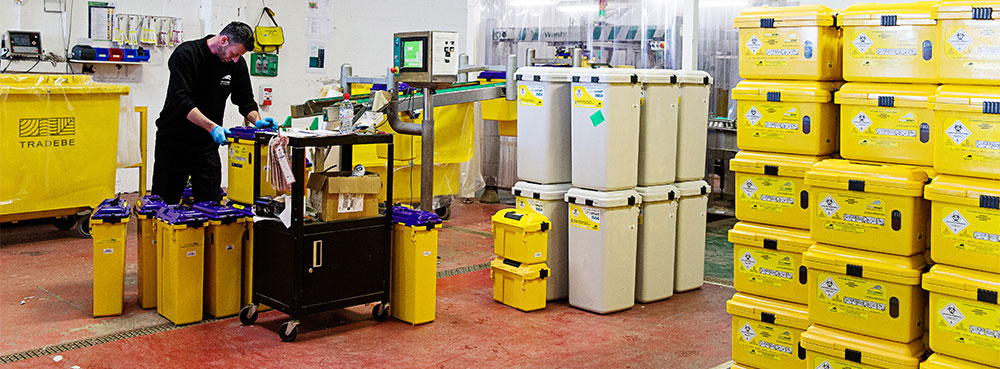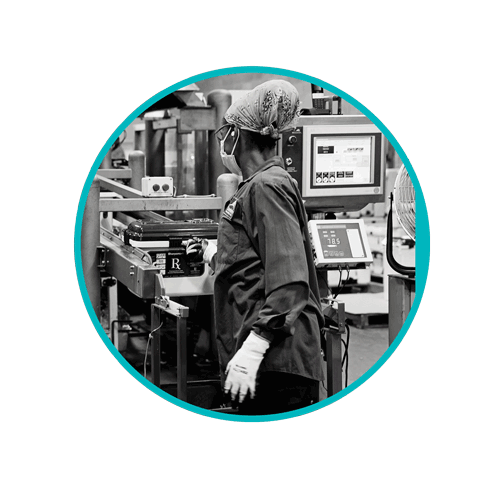How Our Reusable Clinical Waste Containers Are Washed and Sanitised

Do you ever worry about the robots coming for our jobs? It’s good to bear in mind that there are some jobs best left to robots…
Our reusable clinical waste containers offer clear sustainability and cost benefits – but how do we make sure they’re clinically safe? How do we ensure infection risks are eliminated every time a container is returned for reuse? At Sharpsmart, safety is built into every stage of the container lifecycle, and that includes our fully automated robotic Washsmart sanitisation system – the validated process that ensures every reusable container returns to service clean, fully compliant and infection risk-free.
Read on to learn more about how our reusable clinical waste containers are washed and sanitised.
TOPICS WE WILL COVER:
1 / What Is the Washsmart System?
2 / The Washsmart Process Explained
3 / How the Washsmart Exceeds Requirements for Microbial Removal
4 / Quality Assurance Is Part of the Washsmart Process
5 / Independent Oversight and Terry Grimmond’s Findings
6 / The Sustainability Payoff of Reusable Containers
7 / Let’s Make Healthcare Safer, Together
What Is the Washsmart System?
 The Washsmart system is Sharpsmart’s proprietary robotic washline, used in all of our UK healthcare waste treatment plants to sanitise and validate our reusable containment systems.
The Washsmart system is Sharpsmart’s proprietary robotic washline, used in all of our UK healthcare waste treatment plants to sanitise and validate our reusable containment systems.
This fully automated, hands-free, precision-controlled system is used not only for decanting clinical waste but also for washing, sanitising and drying cycles of containers – using high-pressure washing, heat, and non-toxic biodegradable detergents to eliminate all microbial contamination and achieve high-level disinfection.
The Washsmart is designed explicitly for ‘microbial overkill’, and from the moment a container is scanned and emptied, it’s tracked through each step of the process to ensure full traceability and consistency in every cycle.
The Washsmart Process Explained
Each reusable container goes through eight critical steps during the Washsmart process, designed to meet or exceed clinical hygiene requirements:
#1 Weighing and Scanning: The container is placed onto a conveyor belt, where it is weighed and scanned to ensure traceability to origin.
#2 Decanting and Emptying: Robot arms grasp the container and tip it upside down, safely emptying the contents into a holding bin.
#3 High-Pressure Flushing: Cold water jets are used to flush out residue, including soiling, dried blood and other fluids.
#4 Detergent Washing: The container is washed in a detergent hot water bath at a set temperature using recycled water from earlier stages in the cycle.
#5 Hot Rinse: Containers are placed in a separate chamber where they undergo a high-temperature final sanitisation rinse at 85°C to neutralise microbial threats.
#6 Drying Process: This heat-drying process eliminates any remnants of microbial growth and any lingering moisture through the use of strategically placed high-pressure, high-volume air jets.
#7 SmartGuard Coating: Each container is sprayed with our unique and patented SmartGuard formulation to ensure they’re able to easily shed any body fluids, blood components, or sticky adhesives or dyes that come into contact with them.
#8 Quality Control Check: This final stage involves a 15-point quality assurance check for cuts, stability, smears, or defects before re-release. This process exceeds hospital-level cleaning requirements.
How the Washsmart Exceeds Requirements for Microbial Removal
The Washsmart process achieves a minimum 6-log reduction in bacterial load – that’s a 99.9999% kill rate of vegetative organisms. This exceeds the 4-log reduction required under international standards, such as ISO 23907-2 for reusable sharps containers.
Why this matters: ISO 23907-2 sets the international benchmark for reusable sharps containers – covering design, microbial safety, and reuse validation. Meeting this standard ensures that our containers are not only clean but also clinically safe and compliant with UK healthcare expectations.
Containers that enter the system with microbial contamination leave with none. Even when challenged with high levels of C. difficile, Staphylococcus aureus, and Enterococcus faecalis in dried whole blood (a soil), Washsmart removed them all.
Quality Assurance Is Part of the Washsmart Process
During the sanitisation process, quality control parameters are constantly assessed, keeping an eye on the timing, temperature, and water volumes required to achieve the high-level disinfection of each container. If any of these parameters are not met or fall outside of our determined criteria, the Washsmart machine shuts itself down to be recalibrated.
Finally, the Washsmart sanitisation process requires all containers to pass a stringent Ninhydrin test at the forensic level to detect any trace of blood or blood components such as proteins.
In addition to the automated wash validation, every container is inspected by trained staff using Sharpsmart’s 15-point Quality Assurance Process, to check for:
- Residual soil or contamination
- Container integrity (no cracks, leaks, or distortion)
- Cleanliness of surfaces
- Proper functioning of lids and hinges
This human oversight ensures clinical end users receive containers that meet not only microbiological safety standards, but also visual cleanliness and usability expectations.
Independent Oversight and Terry Grimmond’s Findings
World-renowned microbiologist Terry Grimmond has independently validated the Washsmart process in multiple international sites. His testing has confirmed:
- Every Washsmart system tested met or exceeded 6-log reductions.
- Even under extreme test conditions, no pathogens were found post-wash.
- Throughout decades of use, there has never been a cited infection linked to a reusable sharps container, neither at the hospital nor treatment plant level.
Grimmond has also calculated the theoretical infection transmission risk as less than 1 in 400 million – meaning reusable containers pose a negligible to nil risk of pathogen transmission to patients and environments.
But don’t just take our word for it, hear it directly from Terry Grimmond as he provides an overview of how Sharpsmart’s reusable sharps containers are cleaned and sanitised to achieve high-level disinfection.
The Sustainability Payoff of Reusable Containers
One massive benefit of choosing reusable containers is the significant reduction of waste sent to High-Temperature Incineration (HTI). As an example, during a 10-year period, Yeovil District Hospital achieved a 10-tonne per year annual decrease in the incineration of virgin plastic when compared to single-use sharps bins. This resulted in a CO2e reduction of 13.5 tonnes and a diversion of 2.39 tonnes of sharps waste from HTI.
Read the full case study here.
By default, reusability equates to sustainability and helps push waste up the waste hierarchy into more favourable positions, as well as reducing overall waste volumes.
And choosing reusables doesn’t mean compromising on safety to achieve sustainability goals – it means improving it. The Washsmart system ensures that every Sharpsmart reusable returns to use free of infection risk and meets the highest safety and quality standards.
Let’s Make Healthcare Safer, Together
At Sharpsmart, we’ve taken infection control and clinical safety seriously from day one, and we’re proud to support healthcare providers across the UK in building safer, smarter systems that protect healthcare professionals and patients alike.
Whether you’re looking for guidance and advice, clinical waste services, or a reliable sharps waste disposal service that prioritises safety, we’re here to help.
Contact us today to speak to one of our experts and work towards making healthcare safer for everyone in your facility.
Let's Talk!
Your time is valuable, and we don’t want to play hard to get. You can either phone us directly on the details listed on our contact page, or feel free to fill out this short form and one of our team members will get back to you as quickly as possible.

